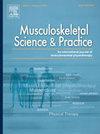在接受跟腱病治疗的参与者中,自我报告的运动依从性措施与疼痛和功能结果相关吗?一项随机对照试验的二次分析
IF 2.2
3区 医学
Q1 REHABILITATION
引用次数: 0
摘要
目的研究跟腱病患者自我报告的坚持12周小腿运动计划是否与疼痛和功能相关。方法对一项随机对照试验进行二次分析,检查127名跟腱病患者进行12周康复计划的自我报告的运动依从性数据。在第6周和第12周通过自我报告问卷收集运动依从性测量-频率,体积和强度以及患者结果- VISA-A和疼痛。结果依从性评估和报告结果测量的完成率很高(91% - 95%)。从6周到12周,坚持频率(78% - 58%)下降,但坚持集合(83% - 79%)和重复在此期间保持稳定(59% - 63%)。疼痛和功能(VISA-A)评分随时间显著改善。线性混合模型显示,坚持训练(p = 0.04)、重复训练(p = 0.013)和增加体重(p = 0.002)与更高的VISA-A显著相关,坚持训练(p = 0.014)与较低的疼痛显著相关,同时还控制了潜在的混杂因素。坚持频率与两种结果都无关。结论:尽管文献中对运动频率的坚持进行了普遍评估,但在跟腱病患者进行为期12周的康复计划时,运动频率与临床结果无关。然而,使用更多的重量和更大的体积可能与临床结果的改善有一定的关系。这项研究强调了研究人员需要改进他们对跟腱病运动依从性的测量和报告。本文章由计算机程序翻译,如有差异,请以英文原文为准。
Are self-reported exercise adherence measures associated with pain and function outcomes among participants receiving treatment for Achilles tendinopathy? A secondary analysis of a randomised controlled trial
Objective
To investigate whether self-reported exercise adherence to a 12-week calf exercise program is associated with pain and function in individuals with Achilles tendinopathy.
Methods
A secondary analysis of a randomised controlled trial, examining self-reported exercise adherence data in 127 participants with Achilles tendinopathy performing a 12-week rehabilitation program. Exercise adherence measures – frequency, volume, and intensity along with patient outcomes - VISA-A and pain, were collected via self-report questionnaires at 6 and 12 weeks.
Results
Completion rates were high (91 %–95 %) for adherence assessments and reported outcome measures. Adherence to frequency (78 %–58 %) reduced from 6 to 12 weeks, but adherence to sets (83 %–79 %) and repetitions was stable over this period (59 %–63 %). Pain and function (VISA-A) scores significantly improved over time. Linear mixed modelling revealed adherence to sets (p = 0.04), repetitions (p = 0.013), and added weight (p = 0.002), were significantly associated with higher VISA-A, and adherence to repetitions (p = 0.014) were significantly associated with lower pain, whilst also controlling for potential confounders. Adherence to frequency was not associated with either outcome.
Conclusion
Although adherence to frequency of exercise is commonly assessed in the literature, it was not associated with clinical outcomes in people with Achilles tendinopathy performing a 12-week rehabilitation program. However, using more weight and doing higher volume may have some relationship with improvement in clinical outcomes. This study highlights the need for researchers to improve their measurement and reporting of exercise adherence in Achilles tendinopathy.
求助全文
通过发布文献求助,成功后即可免费获取论文全文。
去求助
来源期刊

Musculoskeletal Science and Practice
Health Professions-Physical Therapy, Sports Therapy and Rehabilitation
CiteScore
4.10
自引率
8.70%
发文量
152
审稿时长
48 days
期刊介绍:
Musculoskeletal Science & Practice, international journal of musculoskeletal physiotherapy, is a peer-reviewed international journal (previously Manual Therapy), publishing high quality original research, review and Masterclass articles that contribute to improving the clinical understanding of appropriate care processes for musculoskeletal disorders. The journal publishes articles that influence or add to the body of evidence on diagnostic and therapeutic processes, patient centered care, guidelines for musculoskeletal therapeutics and theoretical models that support developments in assessment, diagnosis, clinical reasoning and interventions.
 求助内容:
求助内容: 应助结果提醒方式:
应助结果提醒方式:


